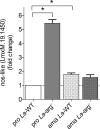Arginase expression modulates nitric oxide production in Leishmania (Leishmania) amazonensis
- PMID: 29135983
- PMCID: PMC5685479
- DOI: 10.1371/journal.pone.0187186
Arginase expression modulates nitric oxide production in Leishmania (Leishmania) amazonensis
Abstract
Background: Arginase is an enzyme that converts L-arginine to urea and L-ornithine, an essential substrate for the polyamine pathway supporting Leishmania (Leishmania) amazonensis replication and its survival in the mammalian host. L-arginine is also the substrate of macrophage nitric oxide synthase 2 (NOS2) to produce nitric oxide (NO) that kills the parasite. This competition can define the fate of Leishmania infection.
Methodology/principal findings: The transcriptomic profiling identified a family of oxidoreductases in L. (L.) amazonensis wild-type (La-WT) and L. (L.) amazonensis arginase knockout (La-arg-) promastigotes and axenic amastigotes. We highlighted the identification of an oxidoreductase that could act as nitric oxide synthase-like (NOS-like), due to the following evidences: conserved domain composition, the participation of NO production during the time course of promastigotes growth and during the axenic amastigotes differentiation, regulation dependence on arginase activity, as well as reduction of NO amount through the NOS activity inhibition. NO quantification was measured by DAF-FM labeling analysis in a flow cytometry.
Conclusions/significance: We described an arginase-dependent NOS-like activity in L. (L.) amazonensis and its role in the parasite growth. The increased detection of NO production in the mid-stationary and late-stationary growth phases of La-WT promastigotes could suggest that this production is an important factor to metacyclogenesis triggering. On the other hand, La-arg- showed an earlier increase in NO production compared to La-WT, suggesting that NO production can be arginase-dependent. Interestingly, La-WT and La-arg- axenic amastigotes produced higher levels of NO than those observed in promastigotes. As a conclusion, our work suggested that NOS-like is expressed in Leishmania in the stationary growth phase promastigotes and amastigotes, and could be correlated to metacyclogenesis and amastigotes growth in a dependent way to the internal pool of L-arginine and arginase activity.
Conflict of interest statement
Figures







Similar articles
-
RNA-seq transcriptional profiling of Leishmania amazonensis reveals an arginase-dependent gene expression regulation.PLoS Negl Trop Dis. 2017 Oct 27;11(10):e0006026. doi: 10.1371/journal.pntd.0006026. eCollection 2017 Oct. PLoS Negl Trop Dis. 2017. PMID: 29077741 Free PMC article.
-
L-arginine availability and arginase activity: Characterization of amino acid permease 3 in Leishmania amazonensis.PLoS Negl Trop Dis. 2017 Oct 26;11(10):e0006025. doi: 10.1371/journal.pntd.0006025. eCollection 2017 Oct. PLoS Negl Trop Dis. 2017. PMID: 29073150 Free PMC article.
-
Leishmania (Leishmania) amazonensis induces macrophage miR-294 and miR-721 expression and modulates infection by targeting NOS2 and L-arginine metabolism.Sci Rep. 2017 Mar 9;7:44141. doi: 10.1038/srep44141. Sci Rep. 2017. PMID: 28276497 Free PMC article.
-
Arginase in Leishmania.Subcell Biochem. 2014;74:103-17. doi: 10.1007/978-94-007-7305-9_4. Subcell Biochem. 2014. PMID: 24264242 Review.
-
The impact of arginase activity on virulence factors of Leishmania amazonensis.Curr Opin Microbiol. 2019 Dec;52:110-115. doi: 10.1016/j.mib.2019.06.003. Epub 2019 Jul 12. Curr Opin Microbiol. 2019. PMID: 31306995 Review.
Cited by
-
Toll-Like Receptor and miRNA-let-7e Expression Alter the Inflammatory Response in Leishmania amazonensis-Infected Macrophages.Front Immunol. 2018 Nov 29;9:2792. doi: 10.3389/fimmu.2018.02792. eCollection 2018. Front Immunol. 2018. PMID: 30555476 Free PMC article.
-
Advances in Understanding Leishmania Pathobiology: What Does RNA-Seq Tell Us?Front Cell Dev Biol. 2021 Sep 1;9:702240. doi: 10.3389/fcell.2021.702240. eCollection 2021. Front Cell Dev Biol. 2021. PMID: 34540827 Free PMC article. Review.
-
Altered purinergic P2X7 and A2B receptors signaling limits macrophage-mediated host defense in schistosomiasis.Biomed J. 2024 Dec;47(6):100713. doi: 10.1016/j.bj.2024.100713. Epub 2024 Mar 3. Biomed J. 2024. PMID: 38442854 Free PMC article.
-
CD4+ T Cell-Dependent Macrophage Activation Modulates Sustained PS Exposure on Intracellular Amastigotes of Leishmania amazonensis.Front Cell Infect Microbiol. 2019 Apr 12;9:105. doi: 10.3389/fcimb.2019.00105. eCollection 2019. Front Cell Infect Microbiol. 2019. PMID: 31032234 Free PMC article.
-
Trypanosomatid Infections: How Do Parasites and Their Excreted-Secreted Factors Modulate the Inducible Metabolism of l-Arginine in Macrophages?Front Immunol. 2018 Apr 20;9:778. doi: 10.3389/fimmu.2018.00778. eCollection 2018. Front Immunol. 2018. PMID: 29731753 Free PMC article. Review.
References
-
- Bogdan C (2008) Mechanisms and consequences of persistence of intracellular pathogens: leishmaniasis as an example. Cell Microbiol 10: 1221–1234. doi: 10.1111/j.1462-5822.2008.01146.x - DOI - PubMed
-
- Liese J, Schleicher U, Bogdan C (2008) The innate immune response against Leishmania parasites. Immunobiology 213: 377–387. doi: 10.1016/j.imbio.2007.12.005 - DOI - PubMed
-
- Sacks D, Kamhawi S (2001) Molecular aspects of parasite-vector and vector-host interactions in leishmaniasis. Annu Rev Microbiol 55: 453–483. doi: 10.1146/annurev.micro.55.1.453 - DOI - PubMed
-
- Teixeira DE, Benchimol M, Rodrigues JC, Crepaldi PH, Pimenta PF, de Souza W (2013) The cell biology of Leishmania: how to teach using animations. PLoS Pathog 9: e1003594 doi: 10.1371/journal.ppat.1003594 - DOI - PMC - PubMed
-
- Séguin O, Descoteaux A (2016) Leishmania, the phagosome, and host responses: The journey of a parasite. Cell Immunol 309: 1–6. doi: 10.1016/j.cellimm.2016.08.004 - DOI - PubMed
MeSH terms
Substances
LinkOut - more resources
Full Text Sources
Other Literature Sources
Research Materials
Miscellaneous

